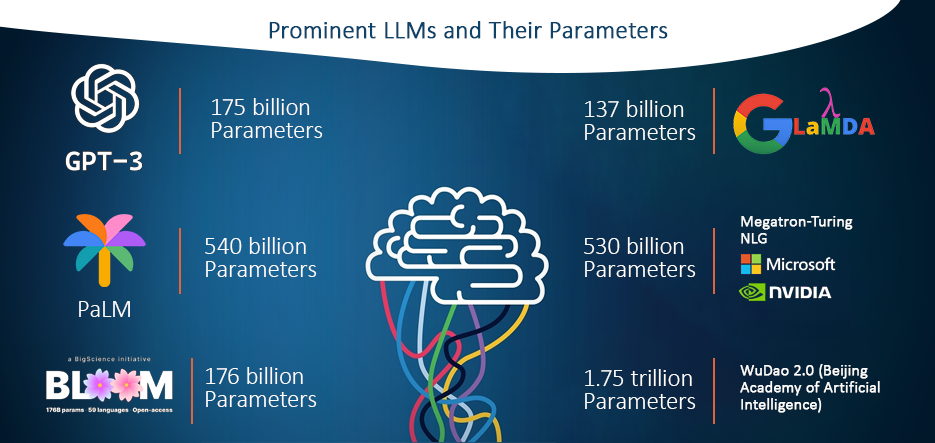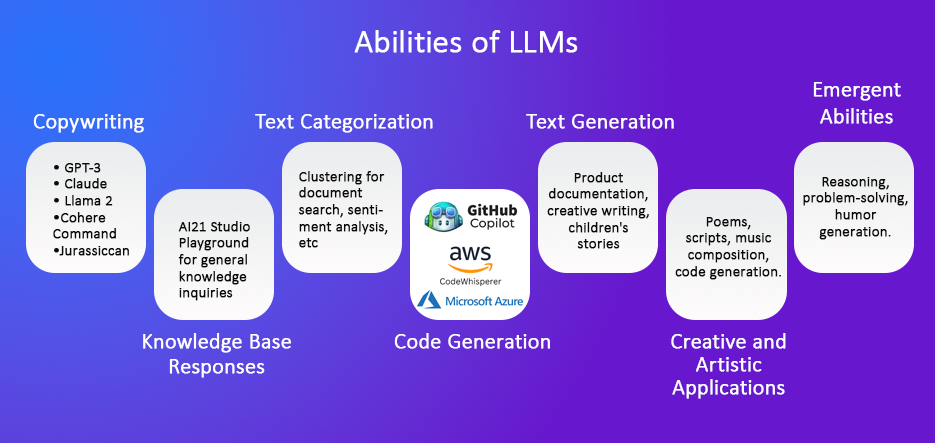Table of Contents
A fascinating field of artificial intelligence called “generative AI” is supported by large language models that have been trained on a sizable corpus of data and are capable of producing data or content. These large language models are constructed on top of a transformer-based deep neural network. Particularly in today’s fast-paced world ,digital business depends on innovation and growth. Innovative solutions are needed to stay up with the changing environment as technology advances at a rate that has never been witnessed before. LLMs are a rapidly expanding sector. By 2029, the market is expected to be valued at $259.89 billion, growing at a compound annual growth rate (CAGR) of 141.72%.
While being adaptable is needed for businesses to remain in the competition; they must always look for new and creative ways to meet the ever-growing demands of a market. We will evaluate the benefits of generative AI tools from a business standpoint and provide some immediate use cases in this blog.
What are Large Language Models?
Large language models (LLMs) are extremely large, pre-trained deep learning models built on massive volumes of data. A collection of neural networks with an encoder and a decoder with self-attention capabilities make up the underlying transformer. The encoder and decoder comprehend the connections between words and phrases in a text sequence and extract meanings from them.
A machine learning LLM is trained using data input/output sets. Often, the text is not tagged or categorized, and the model employs either self-supervised or semi-supervised learning techniques. The LLM receives input in the form of content or information, and its output is an algorithmic prediction for the next word. The input can be confidential company information or, in ChatGPT’s instance, any information that is provided and scraped straight off the internet.
Transformer models, often known as neural networks, are the basis for modern LLMs, which first appeared in 2017. LLM AI can comprehend and produce precise replies quickly with a lot of factors and the transformer model, which makes LLM AI technology widely useful in a variety of application areas.
Collaborate With Us To Integrate Large Language Models Customized For Your Industry
Role of Transformers in Large Language Models
Transformers are capable of self-learning, which is a more accurate description than saying that transformer can train without supervision. They can then pick up fundamental knowledge, language skills, and grammar through this procedure.
The transformers then process whole sequences in parallel, unlike previous recurrent neural networks (RNNs), which process inputs sequentially. This shortens the training period of transformer-based LLMs by enabling the data scientists to train them on GPUs.
It is possible to employ very big models—many with hundreds of billions of parameters—with transformer neural network architecture. These large-scale models can absorb enormous volumes of data, frequently from the internet but also from other sources like Wikipedia, which has roughly 57 million pages, and the Common Crawl, which contains more than 50 billion web pages.
How do large language models work?
The way LLMs represent words is a crucial component of how they function. Previous iterations of LLM machine learning represented each word with a number table. However, links between words, such as those with comparable meanings, could not be recognized by this type of representation. The workaround for this constraint was to represent words using multi-dimensional vectors, also called word embeddings, such that words with related contextual meanings or other associations are next to one another in the vector space.
Transformers can comprehend the context of words and phrases with similar meanings as well as other relationships between words, such as parts of speech, by using word embeddings to pre-process text as numerical representations through the encoder. After that, LLMs can use the decoder to use their language knowledge to create a unique output.

Abilities of large language models (LLMs)
Large Language models have so many abilities that are yet to be discovered. Some of the common potentials of LLMs include-
Copywriting
In addition to GPT-3 and ChatGPT, Claude, Llama 2, Cohere Command, and Jurassiccan can be used to generate content. To enhance style and voice, it is recommended to modify the original sentences.
Knowledge base responses
Frequently we denote knowledge-intensive natural language processing (KI-NLP), the methodology that pertains to LLMs that are capable of providing target responses to information requests from digital archives. One such is the AI21 Studio playground’s capacity to respond to inquiries about general knowledge.
Text Categorization
Text having comparable attitudes or meanings can be grouped by LLMs using clustering. Applications include document search, assessing the link between texts, and quantifying consumer sentiment.
Code Generation
When given natural language prompts given by an expert AI prompt engineering company LLM can generate code with ease. Some examples of large language models for code generation include GitHub Copilot, which can code in Python, JavaScript, Ruby, and several other programming languages, is one example, as is Amazon CodeWhisperer, an Amazon large language model, Azure large language models and Open AI’s codex. Writing shell commands, designing websites, and constructing SQL queries are some further coding uses.
Text Generation
Text generation may produce product documentation, finish out unfinished sentences, and, like Alexa Create, compose a little children’s narrative. This functionality is similar to code generation.
Creative and Artistic Applications
LLM AI can write poems, scripts, musical pieces, and even code, pushing the boundaries of human creativity and collaboration. They can personalize user experiences by adapting content and recommendations based on individual preferences and context. By hiring a reliable large language model development company, businesses can take advantage of its limitless potential.
Emergent Abilities
LLMs are capable of developing abilities that go beyond what they are explicitly getting training for. This includes reasoning, problem-solving, and even humor generation. These emergent abilities hold immense potential for future applications, pushing the boundaries of what LLMs can achieve.

Adaptation Of Large Language Models In Industries
Many of the companies are slowly but surely adapting and integrating Large Language Models into their business models. As a result, businesses can function in a smoother way making it easier for clients and employees to operate in an organized way. Let’s take a look at some of the fields in which businesses have adopted multimodal LLM–
1. Healthcare
The healthcare industry is vast with large amounts of patient data and literature. The global Generative AI in healthcare market size was estimated at USD 22.45 billion in 2023 and is expected to expand at a compound annual growth rate (CAGR) of 36.4% from 2024 to 2030. Meanwhile, there is the struggle to provide better services and improved patient care Large Language Models come in handy here. Nearly 47% of healthcare organizations are already using or planning to use LLM AI for various applications. Patient care can be compromised by labor-intensive, slow-moving manual data analysis and interpretation techniques that frequently fall behind the quick speed of medical developments.
Healthcare organizations can improve patient care, research, and data protection by utilizing large language models’ capabilities in their procedures. Healthcare continues to be ethical, effective, and well-informed thanks to its capacity to comprehend, produce, and summarize text-rich data.
- Medical Record Analysis: By parsing and summarizing medical records, large language models let healthcare providers swiftly obtain vital patient data.
- Disease Diagnosis: By evaluating patient data and medical literature, they assist physicians in making well-informed diagnoses.
2. Finance
Financial Large Language Model (LLM) applications are very beneficial to the financial services industry. They analyze large amounts of financial data, extract insightful information, and help make well-informed decisions by using advanced machine learning (ML) and natural language processing techniques. Numerous domains, including risk assessment, fraud detection, customer service, compliance, and investment strategies, can benefit from the use of these models.
- Stock Market Analysis: To forecast market movements and support traders, these models can analyze enormous volumes of financial data as well as news items.
- Risk Assessment: By examining loan applications and financial documents, large language models assist financial organizations in determining the level of credit risk.
3. Education
The field of education and learning is expanding in promise as we continue to realize the possibilities of artificial intelligence. The models like ChatGPT large language model, an AI model that can comprehend and produce prose that resembles that of a human, are among the pantheon of LLM AI technologies that are proving to be transformative for instructional programming. Language models can modify content and provide materials that are specifically tailored to the skills and interests of each student.
Also Read: Role of AI in education
4. Marketing
Large Language Models are still in their early stages of development, but they have the potential to revolutionize the marketing sector. These, however, will become increasingly useful tools for businesses to employ as they grow, assisting them in reaching their target audiences and achieving their marketing goals. The usage of Large Language Models in marketing initiatives is becoming popular. They may be utilized to produce leads, personalize information for consumers, and even automate customer support.
- Content Generation: The time and effort needed for content marketing are decreased by using large language models to automate the development of material for blogs, websites, and social media.
- Client Assistance Chatbots: They provide the intelligence for chatbots that can respond to consumer questions and make tailored recommendations.
5. Legal
The traditional judicial sector has been greatly altered by the development of artificial intelligence services. Additionally, AI and law have found applications in several fields recently with the emergence of AI-generated content (AIGC), such as interactive chat, automatic text generation, and image recognition. Large models are becoming more and more popular, and artificial intelligence will lead to significant changes in the traditional judicial sector.
- Legal Document Analysis: By evaluating and summarizing legal documents, contracts, and case law, these models help legal practitioners.
- Legal Research: They expedite legal research by locating pertinent precedents and case law fast.
6. Journalism
Over the past few years, AI has progressively become more prevalent in journalism. Examples of AI’s expanding impact in this industry include data journalism, content recommendation algorithms, and automated news creation and dissemination. But this trend has intensified with the introduction of Large Language Models like GPT-3 and BERT, presenting both new opportunities and difficulties.
- News Generation: By producing news stories and summaries based on unprocessed data and events, large language models help journalists quickly provide breaking news updates.
- Fact-Checking: Cross-referencing data from multiple sources aids in fact-checking information and pointing out false information.
7. Customer service
If there is any field where Large Language Models have made their mark, it is the customer service sector. A generative AI development company can revolutionize the customer service industry by providing AI solutions which has been bringing a revolution in the way businesses are now interacting with their customers. They are resulting in a new unmatched efficiency customization and accessibility. With customers working around the clock. Businesses need to be available around the cock. This is where AI solution providers come coming handy making customer service a game changer in every business.
- Chatbots and Virtual Assistants: Chatbots and virtual assistants are powered by language models and offer prompt answers to consumer questions, increasing the effectiveness of customer service.
8. Translation Services:
Language barriers can be one of the biggest hindrances in global communications. The training of Large Language Models is on large databases for exact language translation to make communication easier. These are so much smarter and more flexible when it comes to interpreting commands and prompts. This new technology opens a lot of new possibilities in terms of model customization with business data.
- Language Translation: By offering more precise and contextually aware translations in several languages, they improve translation services.
- Language Tutoring: They help students become more fluent in a language by offering them immediate feedback and support.
9. Entertainment and Content Creation:
A revolution built on data and placing the customer at the heart of every experience is currently taking place in the media and entertainment sector. In addition to producing original content, LLMs can replicate human-like interactions and have a thorough comprehension of complex knowledge. It empowers data in the entertainment and media sectors to generate new revenue streams and real-world effects.
- Scriptwriting: With the help of these models, screenplays for films, TV series, and video games can be produced.
- Creative Writing: They serve as a source of inspiration and ideas for writers and content producers.
10. Government and Public Sector
This is one of the areas where LLM has not been able to make its mark. However, some uses of LLM can help in better understanding the consumers.
- Policy Analysis: With the help of prompt engineering company, language models help decision-makers assess public opinion and comprehend the effects of changing policies.
- Administrative Efficiency: They can expedite the processing of applications and inquiries from citizens, among other administrative responsibilities.
Explore Limitless Potential With Large Language Model Development
Use Cases of LLM’s in Businesses
LLM has been revolutionizing different industries and they are proving to be an asset across various sectors. Let’s take a look at the various ways businesses can make use of Generative AI services for smooth operations.
Chatbot/Virtual Assistants
Customer service and engagement are evolving, and LLMs are driving this change. With the help of LLMs, chatbots and virtual assistants can answer complicated questions, provide tailored recommendations, and have human-like conversations—all of which improve user experiences and boost productivity.
Energy providers, such as Essent, face a steady stream of requests for customer support. For many years, the company believed that the company’s main customer service tool was a telephone. However, Essent realized that to stay ahead of the competition and handle the increasing volume of customer service inquiries, it would have to completely revamp its business practices.
The business recognized a market for LLM-based chatbots. By utilizing this cutting-edge technology, Essent was able to satisfy the expanding demands for customer service.
Sentiment and Trend Analysis
A variety of Artificial intelligence development companies are using sentiment analysis with Large Language Models to monitor brand impressions, predict market trends, and ascertain public opinion. Large Language Models assist organizations in making well-informed decisions, optimizing their marketing strategies, and maintaining a competitive edge by analyzing extensive statistics.
Sprinklr, a tool for social media management and client engagement, utilizes extensive language models to perform sentiment analysis. This helps companies keep an eye on and participate in social media conversations about their product or brand. The platform from Sprinklr examines social media data to find sentiment trends and offer insightful information on the tastes and behavior of its users.
Content Generation
The traditional methods of content writing are being altered by Large Language Models. They can produce product descriptions, reports, and articles of superior quality. Consistency and authenticity can be guaranteed by tailoring the content produced by Large Language Models to specific brand voices. The following are a few notable Large Language Models that are utilized in various areas for content creation:
- GPT-3, 4: These multimodal LLM are excellent in creating human-like dialogue, copywriting, translating, and performing numerous other language-related jobs.
- LaMDA: Google’s LaMDA is intended to generate text and have interesting discussions, providing useful applications in human interaction.
- Megatron-Turing NLG: Known for its robust support for numerous languages, Megatron-Turing NLG is a flexible language model that is utilized for an extensive array of text-based jobs.
- DALL-E, Stable Diffusion, and MidJourney: These models are highly skilled at producing visuals from verbal descriptions, creating new opportunities.
Personalization
Large Language Models are being used by streaming services and e-commerce platforms to provide users with customized suggestions. By customizing content, goods, and services to each person’s preferences, these models improve customer happiness and retention. They do this by analyzing user behavior and preferences.
For example, the supermarket delivery business Instacart uses LLMs to respond to inquiries about nutrition and provide tailored product suggestions.
Challenges of Large Language Models
While LLM offers various advantages, it also has some limitations and challenges that businesses need to be aware of before they become completely reliant on AI. François Chollet, an AI researcher at Google said” Large language models are powerful tools, but their deployment comes with responsibilities”.
Mentioned below are some of the challenges that need to be addressed for a smoother business implementation-
Data training bias
Large-scale datasets are used to train LLMs, yet these datasets could include bias from the sources. Therefore, it’s possible that content produced by LLM willfully reinforces or amplifies this bias. To detect and eliminate bias, audit and improve LLMs regularly. However, to lessen skews in the output, use bias detection methods and guidelines when training the model. To reduce inherent bias, think about diversifying the training datasets as well.
Security and Privacy of Data
LLMs frequently deal with private or sensitive client data. Data breaches may arise from inadequate security measures. Adopt strong data security procedures, such as encrypting sensitive data, limiting access to data to authorized workers, and adhering to applicable data protection laws (e.g., GDPR, HIPAA). Update security procedures often to keep up with new threats.
Employee Resistance and the Learning Curve
Workers used to traditional workflows could object to LLM integration because they see them as competitors or threats to their jobs. Invest in extensive training courses to help staff members become more skilled and knowledgeable about LLM technology. Use change management techniques that highlight the advantages of LLMs in increasing productivity and efficiency while including staff members in the transition process.
Over-Reliance on AI
Relying excessively on LLMs can weaken the authenticity and creativity of a brand, particularly when it comes to creating messaging for business communication. Achieve a balance between human inventiveness and automation. Instead of trying to replace human creativity, use LLMs as tools to support and enhance it. Review and modify content produced by LLM regularly to ensure that it stays true to the voice and values of your company.
How Companies Are Leveraging Conversational AI to Overcome The Challenges
Companies encounter a variety of difficulties in the fast-paced world of today, including growing operating expenses and client demands. However, conversational AI has become a potent ally amid the mayhem. With the help of chatbots and virtual assistants, this cutting-edge technology is revolutionizing how companies interact with their clientele and overcome internal obstacles.
Thus, what specific strategies are businesses using Conversational AI to address these issues?
Now let’s examine a few actual instances:
1. Mastering Customer Support
Availability Round-the-Clock: Eliminate hold times! Chatbots offer immediate assistance, managing basic questions and elevating complicated problems. In addition to increasing client happiness, this frees up human agents for more difficult jobs.
Customized Exchanges: Imagine having a virtual assistant that recalls your preferences and previous exchanges. Conversational AI enables companies to provide individualized assistance by customizing recommendations and responses to each customer’s needs.
Lower Operating Expenses: Chatbots greatly lessen the workload of human agents by automating routine operations like tracking orders and answering frequently asked questions. This results in more efficiency and cheaper running expenses.
2. Creating Internal Process Streamlines
Employee Onboarding: By guiding new hires through the process, responding to inquiries, and giving them access to resources, conversational AI-powered assistants may expedite and streamline it.
Internal Communication: Picture yourself having a single point of contact for all of your internal communications. Chatbots can be used to plan meetings, exchange information, and respond to staff inquiries, which can improve teamwork and output.
Data-Driven Insights: Businesses may learn a lot about the demands of their customers and the problems of their employees by examining chatbot interactions. Making data-driven decisions and refining strategies and procedures are then possible with the use of this data.
3. Overcoming Linguistic Barriers
Global Reach: By eliminating language barriers, conversational AI helps businesses engage with clients all around the world. Real-time conversation translation by chatbots opens up new markets and increases clientele.
Enhanced Accessibility: Consider assisting clients who have impairments. To ensure accessibility and inclusion, conversational AI assistants can communicate with clients via text, voice, or even sign language.
Also read: Conversational AI Vs. Chatbots
Generative AI vs Large Language Models
| Criteria | Generative AI | Large Language Model (e.g., GPT-3) |
|---|---|---|
| Definition | Generates new content based on input data. | Processes and understands natural language text |
| Training Data | Requires diverse datasets for generation | Trained on a massive amount of text data |
| Use Cases | Creative content generation, art, music | Natural language understanding, text generation. |
| Output | Diverse and creative, not limited to text | Predominantly text-based output |
| Training Complexity | Can be complex and depends on the task | Training is computationally intensive |
| Fine-Tuning | May require fine-tuning for specific tasks | Fine-tuning is possible for specific applications |
| Interactivity | Can be interactive, responding dynamically | Typically responds to input sequentially |
| Model Size | Varies depending on the task and complexity | Large model size, e.g., GPT-3 has 175 billion parameters |
| Comprehension | Limited in understanding context and nuances | Good at understanding and generating coherent text |
| Potential Bias | May inherit biases present in training data | Can exhibit biases present in the training data |
| Realism | Can produce realistic and imaginative content | Generates coherent and contextually relevant text |
Future of LLM’s
The advent of large language models capable of producing text and answering inquiries, such as ChatGPT open-source large language models, Claude 2, and Llama 2, suggests intriguing future developments. LLM performance is becoming closer to that of humans gradually but steadily. The rapid success of these LLMs indicates a strong need for robotic-type LLMs that mimic and, in certain cases, surpass the capabilities of the human brain. Here are some ideas regarding what lies ahead for LLMs.
Enhanced capacity
Despite how amazing they are, neither LLMs nor the state of technology today are flawless. However, when engineers learn how to improve their performance while lowering bias and eliminating wrong replies, later releases will have greater capability and accuracy.
Audiovisual Instruction
Although most LLMs are trained with text, several developers also train these models with audio and video input. This type of training ought to expedite the construction of models and create new avenues for the application of LLMs in autonomous cars.
Workplace Transformation
The workplace is going to alter because of LLMs. Similar to how robots eliminated tedious and repetitive manufacturing tasks, LLMs probably will as well. Simple automated copywriting, customer support chatbots, and repetitious administrative duties are among the possibilities.
Conversational Artificial intelligence
Without question, conversational AI applications will enhance the functionality of automated virtual assistants such as Siri, Google Assistant, and Alexa. They will be more adept at deciphering user intentions and carrying out complex requests.
Connect With Our Dedicated Experts for LLM Development and Achieve Exponential Transformation
Conclusion
To sum it up, Large Language Models can completely transform a wide range of sectors’ businesses. Your company can successfully adopt these models if it uses the appropriate technological know-how and reliable methods to identify the wants and goals of your customers.
Although using LLMs can provide your company with a competitive edge, nevertheless they have drawbacks as well. Large language models are potent instruments with the potential to boost customer satisfaction, spur innovation, and streamline business processes. Businesses that can hire AI developers to gain a competitive edge must comprehend the nuances of LLMs and meanwhile take in the factors that should be taken into account before implementing them.
FAQs
What are Large Language Models (LLMs)?
Large Language Models are extremely pre-trained deep learning models built on massive volumes of data. They use transformer-based neural network architectures and can comprehend and generate human-like text.
How do Large Language Models work?
LLMs represent words using multi-dimensional vectors (word embeddings) and use transformers to process sequences in parallel, allowing for faster training on GPUs. The encoder and decoder in the transformer model understand connections between words and phrases.
What is the role of transformers in Large Language Models?
Transformers play a crucial role in LLMs by enabling self-learning capabilities. They process whole sequences in parallel, allowing for faster training and the absorption of vast amounts of data, making LLMs versatile in various applications.
What are the abilities of Large Language Models?
LLMs have diverse abilities, including copywriting, knowledge base responses, text categorization, code generation, text generation, creative and artistic applications, and emergent abilities such as reasoning and problem-solving.
How do industries adapt Large Language Models?
Industries like healthcare, finance, education, marketing, legal, journalism, customer service, translation services, and entertainment are adopting LLMs for tasks such as medical record analysis, risk assessment, personalized learning, content generation, legal document analysis, news generation, and more.
What challenges do Large Language Models pose?
Challenges include data training bias, security and privacy concerns, employee resistance, overreliance on AI, and the potential to weaken brand authenticity. Businesses need to address these challenges for successful implementation.






